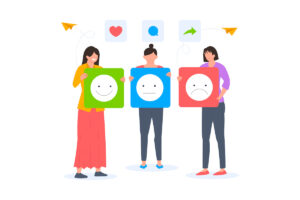You can almost find yourself starting to dehumanize people when you put their career paths on a pedestal.
As a leader, you might feel that there’s often a gulf of understanding between yourself and colleagues. And you’re probably prone to biases and preconceived ideas about your team too. “Well, they’re still at that level because they’ve never worked hard enough”.
Measuring other’s accomplishments through your own lens and applying your personal metrics for success isn’t professional and it’s completely unfair – and vice versa.
This can apply to anywhere that you’re a leader too – at home, the workplace, in your community.
A key component in building trust is vulnerability. Sharing struggles and personal difficulties is about connecting to colleagues, understanding their perspectives and their lived experiences. When you do this, you can build teams that play to people’s strengths and accommodate and include everyone.
Sharing Weakness
No-one is infallible and we all make mistakes. Pretty obvious, right? But you’d be surprised how many people try to pretend that this isn’t a universal fact.
Accepting that you and those around you are just trying your best and all muddling through life is one of the first steps towards improving your relationships with everyone around you.
[Tweet “”People are different and they process information and communicate in different ways.” via @bryankramer”]
Expecting perfection will lead to a very disappointing set of circumstances and encouraging people to cover up their weaknesses will lead to damaging behaviors and a detrimental impact on esteem.
And vulnerability isn’t about telling every man, woman and their dog your deepest darkest secrets – it’s about acknowledging that you need to help with tasks and help to get to the level you’re at. Everyone needs help.
Vulnerability Loop
During Daniel Coyle’s research, he spoke to Jeff Polzer, a professor of organizational behavior at Harvard, who states that if you can create a vulnerability loop then trust can increase.
This can happen by having a direct conversation with others about your weaknesses. It doesn’t have to be this emotional tell-all moment – it’s mainly around providing clarity to someone about things you need to work on or need help with. How the other person reacts to you is the key component of a successful vulnerability loop.
You can start by opening up and communicating a vulnerability, the other person will hopefully pick this up and share their own vulnerabilities. You’ll then comment on what they’ve told you and discuss what you’ve shared. Increased trust will be established and your relationship will be deepened.
It might not necessarily work out exactly like described. The other member of your conversation may not feel comfortable opening up and sharing their vulnerabilities with you and this could be for loads of different reasons. For example, if you’re a CEO or a leader in a company, someone might feel fearful about telling you things for fear of confidentiality or the consequences of saying they struggle.
With this in mind, you don’t have to make sharing vulnerabilities face-to-face or one-to-one conversations as this can overwhelm people. And again, this is a key learning moment. People are different and they process information and communicate in different ways.
Starting a dialogue starts to shift dynamics though and can help to create a more open, caring environment.
Often, people think that opening up and being vulnerable comes after trust, but actually, once you switch this equation around, it can be vulnerability that leads to trust and more meaningful relationships.
Breaking the Ice
The powers of hearing someone utter the words ‘hey, I feel the same’, ‘I was really nervous about this’ or ‘this might be a stupid idea, but…’ can be really beneficial. Events or new scenarios can cause lots of worrying and hesitation.
When you know people are sharing that with you, you can almost feel the burden being halved. This can help to tackle obstacles and get you on your way to making progress on whatever task you’re focusing on.
It also means people feel more confident about chipping in with ideas and telling everyone what they really think about a subject. You’re unlocking creativity, empathy, and openness when people embrace and accept vulnerability.
Final Thoughts
Collaboration and cooperation are bonding tools that allow groups to get stronger and more effective. At the heart of this, if the members can have honest conversations where they acknowledge that asking for help isn’t a weakness, everyone can thrive. Being given permission to tell your truth and learn together leads to better results.





